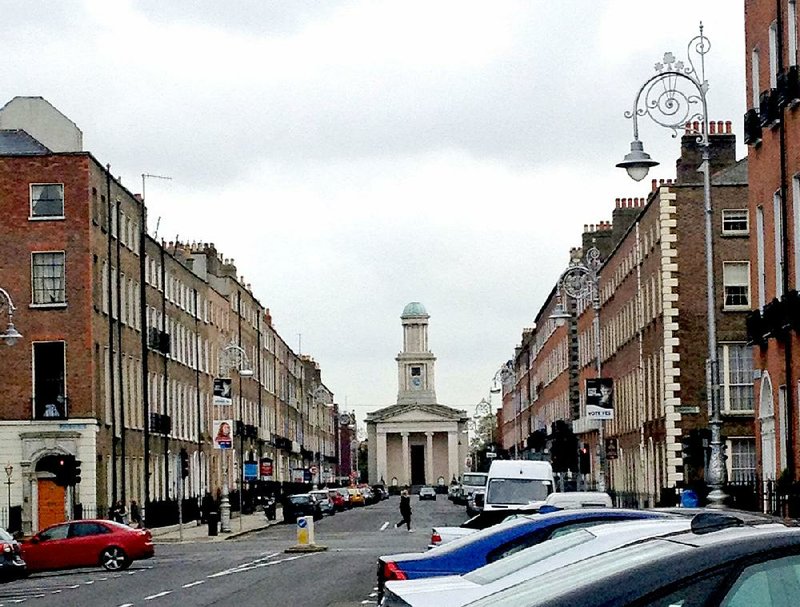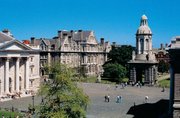DUBLIN - This is the year of The Gathering Ireland 2013. It’s an invitation to the worldwide Celtic diaspora, and everyone else who loves the irrepressible Irish, to join a yearlong celebration across the Emerald Isle. One stop on everyone’s list will surely be Dublin. Along with crawling a few pubs, feet tapping to the fiddles and whistles of local musicians, and checking out the uber-hip Temple Bar area, there’s Georgian Dublin to explore. For architecture and history fans, this is a must.
The Georgian style of architecture, design and decor flourished during the reigns of the four King Georges, from 1714 to 1830, reaching its apogee of refinement and splendor in the 18th century when Dublin was the second largest city of the British Empire, and the fifth largest in Europe. Follow the story of Georgian architecture, and you track the often turbulent history of the Irish. This is history etched in stone.
With roots in the classic symmetry of the Italian architect Andrea Palladio, the characteristic columns, porticoes, pediments and sometimes domes of the Georgian period often marked government headquarters, museums and other civic buildings, declaring their importance in granite and Portland stone. Among the most notable: the Custom House; the Royal Exchange, now the City Hall; the first Parliament House, now part of Trinity College; and Leinster House, Ireland’s Parliament since 1922. Along with Ireland’s fortunes, most of these buildings changed roles over time.
These buildings are scattered around Dublin, but the place for one-stop viewing is Trinity College’s Parliament Square, enclosed on three sides by a superb ensemble of Georgiana. Now a busy college quadrangle dotted with parked bikes, it was where the original Irish Parliament met until Ireland joined with the United Kingdom of Great Britain and Dublin was no longer the capital. The historic building on the south side of the cobbled plaza is now the Examination Hall. It is opposite the chapel, the dining hall and other college facilities.
Commanding the fourth side is the iconic Bell Tower, built a century later, and beyond it the spacious green and the Old Library housing Ireland’s greatest treasure, the Book of Kells. Georgian Dublin is even better known today for its domestic architecture, those terraced townhouses that line the elegant squares and side streets south of the River Liffey, which bisects the city. But the story begins on the north side where large private homes and smaller residences were first built.
Thanks to the enterprising Earl of Kildare, prime real estate moved across the river in 1745 when he designed a large Georgian mansion (now Leinster House) on the less tony south side not far from Trinity College, betting the aristocracy would follow him. It did, and soon Dublin’s loveliest squares, notably Merrion and Fitzwilliam, sprang up nearby and became the heart of what is now the best-preserved part of Georgian Dublin.Here were the city homes of the wealthy landowners who lived in Dublin mainly during the glittering social party season, from New Year’s to St. Patrick’s Day, and when Parliament met.
Georgian Dublin owed much of its integrated look to the newly created Wide Streets Commission of 1757, a city planning body that laid out broad streets, districts and the location and placement of buildings. This promoted serenely cohesive terraced townhouses. Mainly brick, with high-pitched slate roofs, they sat side by side with gardens in the rear, forming long blocks almost identical in appearance. Owners differentiated their homes with distinctive ironwork, delicate fanlights over doors painted bright primary colors and framed by columns, that have become a signature of Georgian Dublin. Typically, houses were four stories tall, plus a basement for kitchen and staff bedrooms. The tallest ceilings and windows were in the public rooms on the lower floors, decreasing in height on upper floors, through the adults’ bedrooms, to the smallest in the children’s rooms on the top floor. One clue to the owner’s wealth was the number of windows across the facade, from two to five.
The Act of Union in 1801, which merged Ireland and Great Britain in one kingdom, caused a major change. The Irish government moved to London, and Dublin aristocracy soon preferred to live there, too. Property values of their townhouses dropped, and doctors, writers, poets, and all manner of professionals moved in.Stroll the streets around Merrion Square, for instance, and you’ll see plaques commemorating notable former residents, among them William Butler Yeats (No. 82), the poet George Russell (No. 84) and Oscar Wilde (No. 1). Incidentally, opposite the Wilde house just inside Merrion Square is a popular multicolored stone statue of Oscar Wilde insouciantly lounging on a huge boulder, sporting a green jacket with red lapels and cuffs, gray pants and black shoes. Nearby, two black obelisks are covered with graffitilike Wilde witticisms. Across the street is Wilde’s childhood home, now a cultural facility.
After Ireland’s three-year War of Independence (1919-1922) against the British, Georgian Dublin lost its luster. Many Independent Irish scorned those elegant neighborhoods as “too Union.” The city administration ended the vaunted social season that had kept aristocrats in their townhouses. Some homeowners left for the suburbs and others lost their homes in the 1929 stock market crash. As if that weren’t enough, there was actually talk in Eamon de Valera’s government of demolishing “old-fashioned” Merrion Square. Ironically, it was rescued by the start of World War II, which diverted the country’s attention and capital to more immediate ends.
Fortunately, by the end of the century, the idea of historic preservation was growing, not to mention the value of Dublin’s architectural heritage. The city enacted strict new planning measures to protect what was left of its Georgian neighborhoods.
Today, strolling around central Georgian Dublin, a rectangle roughly bounded by Merrion and Fitzwilliam squares, Trinity College and St. Stephen’s Green, you’ll find plenty of Georgian facades but fewer opportunities to see the interiors, with their beautiful woodwork, elaborate plasterwork, marble fireplaces, and graceful staircases. The Georgian House Museum, also called No. 29 (29 Lower Fitzwilliam St.), re-creates the interior of a typical Georgian house as it would have looked from 1790 to 1820, with original furnishings. A few steps away, Louise Kennedy (56 Merrion Square)refurbished five floors of an 18th-century townhouse to accommodate her fashion boutique.
Close by is The Merrion Hotel, whose main building was created from four 18th-century Georgian homes, one of them the birthplace of the first Duke of Wellington. The original drawing rooms have been impeccably restored, with period fabrics, colors, antiques and spectacular rococo ceiling plasterwork by a master stuccodore. You might end your 18th-century ramble in The Merrion’s very Georgian Drawing Rooms with its distinctly non-Georgian Art Tea that celebrates the hotel’s unusual contemporary art, one of the country’s most important private collections.
IF YOU GO
Several guided walking tours include Georgian Dublin: Pat Liddy’s Walking Tours of Dublin, filled with stories of Irish life and history, offers a Georgian tour on request (www.walkingtours.ie); Historical Walking Tours of Dublin has one on city architecture (www.historicalinsights.ie); Architecture Tours includes a Georgian Dublin walk (www.architecturetours.ie).
For more information about visiting Dublin, check out visitdublin.com.
Travel, Pages 50 on 03/17/2013


